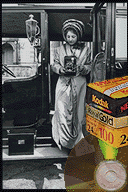|
|
.
E. J. Marey, the painter Thomas Eakins, and Eadweard Muybridge
all devised means for making stop-action photographs that demonstrated
the gap between what the mind thinks it sees and what the eye actually
perceives. Muybridge's major work, Animal Locomotion (1887), remains
a basic source for artists and scientists alike. As accessory lenses
were perfected, the camera's vision extended both telescopically
and microscopically; the moon and the microorganism became accessible
as photographic images.
 The
introduction of the halftone process in 1881made possible theaccurate
reproduction of photographs in books and newspapers. In combination
with new improvements in photographic technology, including dry
plates and smaller cameras, which made photographing faster and
less cumbersome, the halftone made immediate reportage feasible
and paved the way for news photography. George Eastman's introduction
in 1888 of roll film and the simple Kodak box camera provided everyone
with the means of making photographs for themselves. Meanwhile,
studies in sensitometry, the new science of light-sensitive materials,
made exposure and processing more practicable. The
introduction of the halftone process in 1881made possible theaccurate
reproduction of photographs in books and newspapers. In combination
with new improvements in photographic technology, including dry
plates and smaller cameras, which made photographing faster and
less cumbersome, the halftone made immediate reportage feasible
and paved the way for news photography. George Eastman's introduction
in 1888 of roll film and the simple Kodak box camera provided everyone
with the means of making photographs for themselves. Meanwhile,
studies in sensitometry, the new science of light-sensitive materials,
made exposure and processing more practicable.
|

